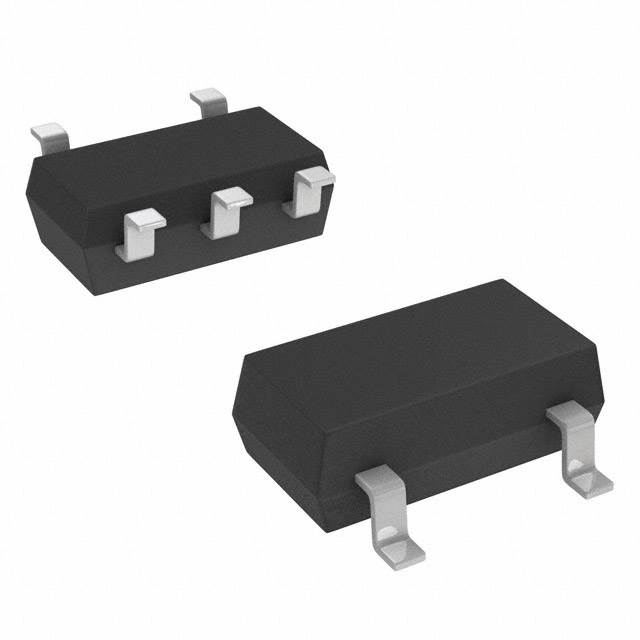NC7S14P5X
Product Overview
- Category: Integrated Circuit (IC)
- Use: Logic Gate
- Characteristics: Schmitt Trigger Inverter
- Package: SOT-23-5
- Essence: High-speed CMOS technology
- Packaging/Quantity: Tape and Reel, 3000 units per reel
Specifications
- Supply Voltage Range: 1.65V to 5.5V
- Input Voltage Range: 0V to VCC
- Output Voltage Range: 0V to VCC
- Maximum Propagation Delay: 6ns at 2.7V
- Maximum Quiescent Current: 10µA at 5.5V
- Operating Temperature Range: -40°C to +85°C
Detailed Pin Configuration
The NC7S14P5X is a 5-pin IC with the following pin configuration:
- GND (Ground)
- A (Input)
- Y (Output)
- VCC (Power Supply)
- B (Input)
Functional Features
- Schmitt Trigger: The NC7S14P5X incorporates a Schmitt trigger input, which provides hysteresis and improves noise immunity.
- Inverter: It acts as an inverter, producing an inverted output signal compared to the input signal.
- High-Speed Operation: With a maximum propagation delay of 6ns, it enables fast switching between logic states.
- Wide Voltage Range: The IC can operate within a wide supply voltage range of 1.65V to 5.5V.
Advantages and Disadvantages
Advantages: - Improved Noise Immunity: The Schmitt trigger input enhances the IC's ability to reject noise and provide stable outputs. - Compact Size: The SOT-23-5 package allows for space-efficient integration into various electronic designs. - Low Power Consumption: The NC7S14P5X consumes minimal power, making it suitable for battery-powered devices.
Disadvantages: - Limited Input/Output Voltage Range: The IC can only handle input and output voltages within the supply voltage range specified. - Single Functionality: It is designed specifically as a Schmitt trigger inverter and may not be suitable for applications requiring different logic functions.
Working Principles
The NC7S14P5X operates based on the principles of CMOS technology. When an input signal is applied to pin A or B, the Schmitt trigger circuitry compares the voltage level with predefined thresholds. If the input voltage exceeds the upper threshold, the output Y switches to a low state. Conversely, if the input voltage falls below the lower threshold, the output Y switches to a high state. This hysteresis ensures noise immunity and stable output transitions.
Detailed Application Field Plans
The NC7S14P5X finds applications in various electronic systems, including but not limited to:
- Signal Conditioning: It can be used to clean up noisy signals by eliminating unwanted fluctuations and providing stable outputs.
- Oscillator Circuits: The Schmitt trigger functionality makes it suitable for generating square wave signals in oscillator circuits.
- Level Shifting: It can be employed to shift logic levels between different voltage domains in mixed-voltage systems.
- Sensor Interfaces: The IC can interface with sensors and convert their analog signals into digital outputs with improved noise rejection.
Detailed and Complete Alternative Models
- SN74LVC1G17DBVR: Single Schmitt Trigger Buffer/Driver
- CD40106BE: Hex Schmitt Trigger Inverter
- 74HC14N: Hex Inverter with Schmitt Trigger Inputs
- MC14584BDR2G: Hex Schmitt Trigger Inverter
These alternative models offer similar functionality and can be considered as substitutes for the NC7S14P5X in various applications.
Word count: 409
Senaraikan 10 soalan dan jawapan biasa yang berkaitan dengan aplikasi NC7S14P5X dalam penyelesaian teknikal
Sure! Here are 10 common questions and answers related to the application of NC7S14P5X in technical solutions:
Question: What is NC7S14P5X?
- Answer: NC7S14P5X is a specific type of integrated circuit (IC) that belongs to the NC7 series of logic gates. It is a Schmitt trigger inverter, which means it converts an input signal into a digital output signal.Question: What is the purpose of using NC7S14P5X in technical solutions?
- Answer: The NC7S14P5X IC is commonly used for signal conditioning, level shifting, and noise filtering applications. It helps ensure reliable and accurate digital signal processing.Question: What voltage levels does NC7S14P5X support?
- Answer: NC7S14P5X operates with a wide range of voltage levels, typically from 1.65V to 5.5V. This makes it compatible with various digital systems and microcontrollers.Question: Can NC7S14P5X be used in both analog and digital circuits?
- Answer: No, NC7S14P5X is primarily designed for digital circuits. It is not suitable for analog applications due to its inherent digital nature.Question: How many inputs and outputs does NC7S14P5X have?
- Answer: NC7S14P5X has one input and one output. It is a single-channel device.Question: What is the maximum frequency at which NC7S14P5X can operate?
- Answer: NC7S14P5X can operate at frequencies up to several hundred megahertz (MHz), depending on the specific conditions and surrounding circuitry.Question: Can NC7S14P5X be used in high-speed data transmission applications?
- Answer: Yes, NC7S14P5X can be used in certain high-speed data transmission applications where signal integrity and noise immunity are critical.Question: Is NC7S14P5X sensitive to electrostatic discharge (ESD)?
- Answer: Yes, like most integrated circuits, NC7S14P5X is sensitive to ESD. Proper ESD precautions should be taken during handling and assembly to prevent damage.Question: Can NC7S14P5X be used in battery-powered devices?
- Answer: Yes, NC7S14P5X is suitable for battery-powered devices as it operates at low power levels and supports a wide voltage range, making it energy-efficient.Question: Are there any specific application notes or reference designs available for NC7S14P5X?
- Answer: Yes, the manufacturer of NC7S14P5X typically provides application notes and reference designs that offer guidance on using the IC effectively in various technical solutions. These resources can be found on their website or through their technical support channels.
Please note that the answers provided here are general and may vary depending on the specific requirements and use cases of NC7S14P5X in different technical solutions.


